Dominique Luchart's Blog, page 647
April 20, 2021
China wants to launch its own Hubble-class telescope as part of space station, ,
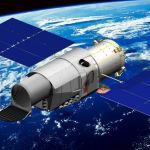
China could launch the first module for its own space station this month as the country also prepares to send a large space telescope to join it in orbit within the next few years.
The Chinese Space Station Telescope (CSST), which is set to launch in 2024, will operate as a space optical observatory for Chinese scientists to carry out sky surveys, according to Xinhua.The telescope, sometimes called “Xuntian,” which literally translates to “survey the heavens,” will have an impressive 6.6-foot (2 meters) diameter lens, making it comparable to the Hubble Telescope Scope. However, it boasts a field of view 300 times greater than that of 31-year-old Hubble while retaining a similar resolution.
The wide field of view will allow the telescope to observe up to 40 percent of the sky over ten years using a huge 2.5 billion pixel camera.Notably, the telescope will co-orbit Earth along with the Chinese space station and will be able to periodically dock with the future crewed outpost.
Related: China selects 18 new astronauts in preparation for space station launch
“The telescope will be set up in an optical module that can fly independently in orbit for a higher efficiency of space probe,” Zhou Jianping, chief designer of China’s human spaceflight program, told China Central Television in March.
“Meanwhile, we will make it fly approximately in common orbit with the future space station. This will help us refuel the telescope and carry out in-orbit upgrade[s] for it, so as to always keep it on the level of an international frontier,” Jianping added.
This could be a big advantage for the CSST, as Hubble required a number of missions to repair, upgrade and replace a variety of components and systems.
Meanwhile, on the ground, four astronomy research centers are being built across China to work with data from the space telescope, Xinhua reported last year.
The CSST will observe near ultraviolet and visible light. Notable cosmological and astronomical objectives include investigating the properties of dark matter and dark energy, the large-scale structure of the cosmos and galaxy formation and evolution, according to a 2019 paper from members of the National Astronomical Observatories (NAOC) under the Chinese Academy of Sciences.
The CSST will also be expected to make contributions to detecting and surveying trans-Neptunian objects (TNOs) and near-Earth asteroids.
Additionally, in preparation for the nation’s new space station, Chinese astronauts are currently undergoing intense training for the first crewed missions to construct the future station.
China is preparing for 11 launches across 2021 and 2022, including four crewed missions, for the construction phase of the project. The core module, named “Tianhe,” meaning “Harmony of the Heavens,” is expected to launch from Wenchang in April, based on previous Long March 5 preparations.
Related: The latest news about China’s space program
Follow us on Twitter @Spacedotcom and on Facebook.
Join our Space Forums to keep talking space on the latest missions, night sky and more! And if you have a news tip, correction or comment, let us know at: community@space.com.
The post China wants to launch its own Hubble-class telescope as part of space station, , appeared first on NEWDAWN Blog.
Gamma-ray bursts don’t get kicked around, ,
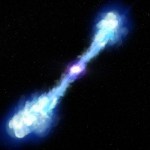
Paul M. Sutter is an astrophysicist at SUNY Stony Brook and the Flatiron Institute, host of Ask a Spaceman and Space Radio, and author of How to Die in Space. He contributed this article to Space.com’s Expert Voices: Opinions and Insights.
Short gamma-ray bursts, which as the name implies are brief blasts of high-energy gamma rays, tend to appear far away from their host galaxies.
For years, astronomers have thought that this means they get a “kick” when they’re born. But new observations prove otherwise: we’ve just been missing all the stars in their neighborhood.
Related: 8 baffling astronomy mysteries
Short and swiftIt took astronomers a long time to figure out what in the universe was causing short gamma-ray bursts. These bursts, lasting less than about two seconds, were first spotted by the United States military when it developed orbiting gamma-ray detectors to sniff out sneaky Soviet nuclear tests. When the detectors went wild (and the panic went away), U.S officials realized that the distant cosmos was much more active than their Cold War adversaries.
The reason that astronomers were having such a tough time of it was that short gamma-ray bursts are a) short and b) rare. That’s a nasty combo for a group of people who depend on being able to see the same thing over and over again to get a handle on it.
Whatever was causing these short bursts, it was brutally energetic and relatively small, even smaller than a star. Astronomers could estimate that last bit based on the duration of the event itself. The average short gamma-ray burst event is around 0.2 seconds long, and if you want an object in space to do something (like, say, blow up), then its actions are always limited by the speed of light. If the event lasts for 0.2 seconds, then that means that one end of the object can be no further than 0.2 light-seconds away from the other end. That comes out to about four times the diameter of Earth.
Adding to the mystery, it wasn’t until 2005 that astronomers finally caught an afterglow from a short gamma-ray burst. Prior to that discovery of X-ray flashes lasting for hours after the main event, all the bursts were isolated affairs.
And it wasn’t until 2017 when astronomers got the final, decisive clue, when a short gamma-ray event coincided with the detection of a gravitational wave. That particular gravitational wave carried the signature of two neutron stars merging — a so-called kilonova.
Neutron stars: Definition and facts
Far away from homeEven though astronomers had finally figured out what caused short gamma-ray bursts, one big mystery remained: their location. Unlike their longer-lasting cousins (long gamma-ray bursts), many of the short ones tended to come from regions of the universe relatively far away from galaxies. They’re not a part of the normal stellar population.
Linking a powerful, rare event like this to its surroundings is a useful astronomical trick. For example, before we fully understood what causes the various kinds of supernovae, astronomers noticed that the Type II class tend to come from elliptical and spiral galaxies, while Type I come from basically wherever. That helped us understand their identities: Type II come from the deaths of massive stars, which are manufactured in abundance within star-forming ellipticals and spirals, whereas Type I come from the destruction of white dwarfs, a much more common and long-lived object that can live anywhere.
And so astronomers have been puzzled by the location of many short gamma-ray bursts. They most definitely come from stars (the neutron stars behind the kilonova events are the remnant cores of large stars), but the short gamma-ray bursts weren’t embedded inside a population of older stars…or any stars at all, for that matter.
This led astronomers to suspect that before neutron stars slam together in a kilonova flash, complicated dynamics “kick” them out of their home and away from their host galaxies. Then, wandering the lonely intergalactic depths, the neutron stars coalesce, leading to a short gamma-ray burst, that one blast of light the only sign of their existence.
Stacks and stacks of starsAnother possibility, as suggested by a paper recently appearing in the preprint journal arXiv, is that we’re getting it all wrong.
By far the vast majority of the stars in a galaxy are concentrated in the very center or within a thin disk. Typically, less than 2% of all the stars are found in the region called the “halo,” which can extend anywhere from 10,00 to 100,000 parsecs away from the galaxy proper. (One parsec is about 3.26 light-years.) Hence the simple reasoning that if we see a large proportion of short gamma-ray bursts coming from within the halo, and stars there are comparatively rare, then the neutron stars that led to the burst must have come from somewhere else.
However, because galaxies are so bright, and there are relatively few stars in the halo, it’s actually notoriously difficult to measure the number of halo stars for any given galaxy. Thus when astronomers have said something like “short gamma-ray bursts come from a very empty halo,” that’s only true in an average, statistical sense.
So the astronomers behind the new study took very deep, long looks at the galaxies that have hosted short gamma-ray bursts — and found that those events were not as isolated as they seemed. In all the cases, they found populations of old stars reaching away from the galactic disk and into the regions of the bursts. Those old stars are more likely to have stellar remnants, like neutron stars, that would eventually collide in an kilonova blast — and an associated short gamma-ray burst.
The conclusion is that there’s no need for a kick. There’s not even really a mystery. Short gamma-ray bursts that occur far outside their host galaxies are there because there are actually more stars in their vicinity than we thought. Neutron stars don’t get randomly ejected from their host galaxies as often as we might have thought. Which, considering just how violent the universe can be, is perhaps the more surprising answer.
Learn more: “No velocity-kicks are required to explain large-distance offsets of Ca-rich supernovae and short-GRBs“
Follow us on Twitter @Spacedotcom or Facebook.
The post Gamma-ray bursts don’t get kicked around, , appeared first on NEWDAWN Blog.
Small NASA rocket will study boundary of interstellar space, ,
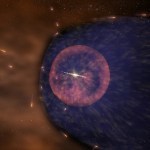
For a few brief minutes, a suborbital rocket from NASA has an ambitious plan to seek out particles from interstellar space.
A mission called Spatial Heterodyne Interferometric Emission Line Dynamics Spectrometer (SHIELDS) will lift off from the White Sands Missile Range in New Mexico no earlier than Monday (April 19.) It will soar to a peak height of 186 miles (roughly 300 kilometers) — a little more than half the altitude of the International Space Station — and peer at the sky for a few minutes with its telescope.
With this capability, it is possible to see light from particles from beyond our solar system even on a short flight outside the Earth’s atmosphere. The mission follows a similar study in 2014; this mission will extend the project’s scope.
Related: These NASA rocket launches to study Earth’s atmosphere are just gorgeous (photos)
To understand what SHIELDS is looking for, it’s best to start with a quick overview of our solar system structure and nearby regions. The planets, asteroids, gas, dust and everything else in our neighborhood is situated in a cluster of gas clouds, called the Local Bubble. The bubble is roughly 300 light-years long and encompasses hundreds of stars, including our own sun.
Inside this structure, our solar system is encased in a magnetic bubble created by the sun that’s known as the heliosphere. As the heliosphere moves through the Local Bubble at roughly 52,000 mph (84,000 kph), particles from interstellar space fall on the heliosphere “like rain against a windshield,” NASA said in a release.
“Our heliosphere is more like a rubber raft than a wooden sailboat: its surroundings mold its shape,” NASA continued in the release. “Exactly how and where our heliosphere’s lining deforms gives us clues about the nature of the interstellar space outside it.”
SHIELDS will examine light from hydrogen atoms that originated in interstellar space. These atoms have equal balances of fundamental particles called protons (positive charge) and electrons (negative charge). Since the positive and negative charges balance each other out, the interstellar hydrogen atoms have a neutral electrical charge, which allows them to cross magnetic field lines.
The mission will look at what happens to the trajectories of the atoms as they creep into the heliopause. “Charged particles flow around the heliopause, forming a barrier, [but] neutral particles from interstellar space must pass through this gauntlet, which alters their paths,” NASA noted.
[image error]
A diagram showing the border of the Local Bubble. (Image credit: NASA’s Goddard Space Flight Center)SHIELDS will seek out the light from these hydrogen atoms and measure how far the wavelength stretches or contracts, which indicates how the particles are moving through space. This information will allow investigators to figure out the shape and matter density around the heliopause barrier — giving some more clues about interstellar space and the clouds within it.
“There’s a lot of uncertainty about the fine structure of the interstellar medium — our maps are kind of crude,” Walt Harris, principal investigator for SHIELDS and a solar and heliospheric researcher at the University of Arizona, said in the same NASA release. “We know the general outlines of these clouds, but we don’t know what’s happening inside them.”
SHIELDS will likely also give scientists insights about the galaxy’s magnetic field, and perhaps allow astronomers to make some predictions about where our solar system will be in the far future. Scientists project that our neighborhood will move out of the Local Bubble in 50,000 years based on its current speed and trajectory, but to where is poorly understood. (It’s far from the first time Earth, the planets and nearby stars have done this, but we haven’t been able to document the phenomenon in real-time before.)
The local observations SHIELDS gathers will augment some data from interstellar space itself. The twin Voyager spacecraft, which launched in 1977, continue to send back observations about their journey through interstellar space. In December, for example, the mission spotted a newly found kind of electron burst that could give more insights into flaring stars.
Follow Elizabeth Howell on Twitter @howellspace. Follow us on Twitter @Spacedotcom and on Facebook.
The post Small NASA rocket will study boundary of interstellar space, , appeared first on NEWDAWN Blog.
On This Day in Space! April 20, 2016: Moon doesn’t turn green, despite internet rumors, ,
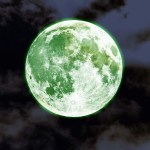
On April 20, 2016, the moon did not turn green. The moon has never been green and will probably never turn green, despite what any viral internet memes may tell you.
This hoax started in 2016 when someone jokingly posted a meme on Facebook claiming that the moon would turn green on May 29. After it went viral, someone thought it would be funny to alter it by changing the date to 4/20 and adding that this only happens every 420 years.
[image error]
NO. The moon did not turn green on April 20, 2016. A online rumor predicting a green full moon was nothing more than a lunar hoax. (Image credit: Space.com/Karl Tate)Allegedly, the moon turns green because of its close proximity to Uranus in the night sky. Uranus actually is green, but it’s also almost 2 billion miles away, and there’s really no way it could illuminate the surface of the moon. It’s so dim that it’s nearly impossible to see without a telescope or binoculars.
Even though the moon failed to turn green, people continue to share these “green moon” memes on social media.
Catch up on our entire “On This Day In Space” series on YouTube with this playlist.
[image error]
History of NASA: $22.99 at Magazines Direct
Discover the story of how and why NASA was created, its greatest triumphs, darkest days, and of the times it exceeded all possible hopes. A tale of adventure, heroism and resourcefulness, learn of the space agency’s greatest achievements and how — over six decades — the organization has consistently and tirelessly devoted itself to its founding principle: that “activities in space should be devoted to peaceful purposes for the benefit of all humankind”. View Deal
Still not enough space? Don’t forget to check out our Space Image of the Day, and on the weekends our Best Space Photos and Top Space News Stories of the week.
Email Hanneke Weitering at hweitering@space.com or follow her @hannekescience. Follow us @Spacedotcom and on Facebook.
Join our Space Forums to keep talking space on the latest missions, night sky and more! And if you have a news tip, correction or comment, let us know at: community@space.com.
The post On This Day in Space! April 20, 2016: Moon doesn’t turn green, despite internet rumors, , appeared first on NEWDAWN Blog.
Venmo is adding support for users to buy, store, and sell cryptocurrency,

Venmo is releasing a feature that will allow users the option to store, buy, and sell popular cryptocurrencies, PayPal announced on Tuesday. Similar to PayPal, Venmo will support four different cryptocurrencies: Bitcoin, Ethereum, Bitcoin Cash, and Litecoin. PayPal had said last year that Venmo would get support for cryptocurrencies.
You can get started with as little as $1, and transactions are managed from the app. Venmo said in a press release that it will begin rolling out the feature to some users today, and tells The Verge it anticipates that “most customers” will have access to cryptocurrencies in the app by the end of May.
 All cryptocurrency transactions will be managed directly from the Venmo app.Image: Venmo
All cryptocurrency transactions will be managed directly from the Venmo app.Image: VenmoVenmo’s support for cryptocurrencies could encourage more people to invest in them. PayPal reported in its Q4 earnings reporter that Venmo had 70 million users; given the app operates like a social network, users may find cryptocurrency more approachable if they can see their friends buying and selling right inside Venmo.
Venmo is the latest payment app to offer support for cryptocurrency. PayPal allowed users to buy, hold, and sell cryptocurrency from the main PayPal app in November and added the ability for US users to make purchases with cryptocurrency in late March. And Venmo and PayPal competitor Square launched support for Bitcoin in its Cash App in 2018.
The post Venmo is adding support for users to buy, store, and sell cryptocurrency, appeared first on NEWDAWN Blog.
April 19, 2021
Watch live at 2 pm ET! NASA to discuss Mars helicopter’s historic 1st flight, ,
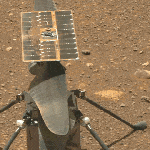
NASA’s Mars helicopter Ingenuity has successfully performed the first flight on the Red Planet on Monday (April 19) and you can watch the results come in live here, courtesy of NASA.
Ingenuity took flight on Mars at 3:30 a.m. EDT (0730 GMT), but with NASA confirming the flight about three hours later. NASA will host a press conference later today at 2 p.m. EDT (1800 GMT) to discuss how the flight went and what’s next for Ingenuity’s test flights.
The $85 million Ingenuity helicopter will be the first powered flight on another world and the first-ever aircraft on Mars. It is expected to make a very short first flight to reach a height of 10 feet and then land.
Related: How to watch the Mars helicopter Ingenuity’s first flight online
Join our forums here to discuss the Perseverance rover and Ingenuity helicopter on Mars. What do you hope they find?
NASA is targeting no earlier than Monday, April 19, for the first flight of its Ingenuity Mars Helicopter at approximately 3:30 a.m. EDT (12:30 a.m. PDT).
Data from the first flight will return to Earth a few hours following the autonomous flight. A livestream will begin at 6:15 a.m. EDT (3:15 a.m. PDT), as the helicopter team prepares to receive the data downlink in the Space Flight Operations Facility at NASA’s Jet Propulsion Laboratory (JPL). Watch on NASA Television, the agency app, website, and social media platforms, including YouTube and Facebook.
If the flight takes place April 19, a postflight briefing will be held at 2 p.m. EDT (11 a.m. PDT).
The participants are:
https://bit.ly/mars-landing-media
The public and media also may ask questions on social media during the livestream and briefing using #MarsHelicopter.
Find the latest schedule updates at:
https://mars.nasa.gov/technology/helicopter/#Watch-Online
The original flight date of April 11 shifted as engineers worked on preflight checks and a solution to a command sequence issue. The Perseverance rover will provide support during flight operations, taking images, collecting environmental data, and hosting the base station that enables the helicopter to communicate with mission controllers on Earth.
This technology demonstration is supported by NASA’s Science, Aeronautics Research, and Space Technology mission directorates. JPL, managed for NASA by Caltech in Pasadena, California, built and manages operations for Ingenuity and the Mars 2020 Perseverance rover.
Follow Ingenuity via the @NASA, @NASAJPL, and @NASAMars Twitter accounts; NASA and NASAPersevere Facebook accounts; and NASA Instagram account.
An Ingenuity press kit is available at:
https://go.nasa.gov/ingenuity-press-kit
NASA will hold a press conference today at 1 p.m. EDT (1700 GMT) to discuss the science launching on SpaceX’s Crew-2 astronaut mission to the International Space Station and you can watch it live here.
A SpaceX Falcon 9 rocket will launch the Crew Dragon Endeavour on Thursday, April 22 to ferry four astronauts to the International Space Station. Liftoff is at 6:11 a.m. EDT (1011 GMT). The mission will be SpaceX’s third crewed flight for NASA and the second operational flight of the Crew Dragon spacecraft.
Called Crew-2, SpaceX’s Crew Dragon launch will carry NASA astronauts Shane Kimbrough, Megan McArthur, Japanese astronaut Akihiko Hoshide and European Space Agency astronaut Thomas Pesquet on a six-month mission to the space station.
NASA will provide coverage of the upcoming prelaunch and launch activities for the agency’s SpaceX Crew-2 mission with astronauts to the International Space Station. This is the second crew rotation flight of the SpaceX Crew Dragon and the first with two international partners. The flight follows certification by NASA for regular flights to the space station as part of the agency’s Commercial Crew Program.
The launch, on a Falcon 9 rocket, is targeted for 6:11 a.m. EDT Thursday, April 22, from Launch Complex 39A at NASA’s Kennedy Space Center in Florida. The Crew Dragon is scheduled to dock to the space station about 5:30 a.m. Friday, April. 23. Prelaunch activities, launch, and docking will air live on NASA Television, the NASA app, and the agency’s website.
The Crew-2 flight will carry NASA astronauts Shane Kimbrough and Megan McArthur – who will serve as the mission’s spacecraft commander and pilot, respectively – along with JAXA (Japan Aerospace Exploration Agency) astronaut Akihiko Hoshide and ESA (European Space Agency) astronaut Thomas Pesquet, who will serve as mission specialists to the space station for a six-month science mission.
All media participation in the following news conferences will be remote except where specifically listed below, and only a limited number of media will be accommodated at Kennedy due to the ongoing coronavirus (COVID-19) pandemic. Please note that the Kennedy Press Site facilities will remain closed throughout these events for the protection of Kennedy employees and journalists, except for a limited number of media who will receive confirmation in writing in the coming days.
NASA’s SpaceX Crew-2 mission coverage is as follows (all times Eastern):
Saturday, April 17
9:45 a.m. – Virtual Crew Media Engagement at Kennedy with Crew-2 astronauts:
NASA astronaut Shane Kimbrough, spacecraft commanderNASA astronaut Megan McArthur, pilotJAXA astronaut Akihiko Hoshide, mission specialistESA astronaut Thomas Pesquet, mission specialistMonday, April 19
1 p.m. – Science Media Teleconference to discuss investigations Crew-2 will support during their mission
David Brady, associate program scientist for the International Space Station Program at Johnson will discuss how the Commercial Crew Program is boosting research aboard the orbiting laboratory. ISS U.S. National Laboratory Senior Program Director Dr. Liz Warren will discuss Tissue Engineering, which uses a combination of cells, engineering, and materials to restore, maintain, improve, or replace biological tissues. Scientists will leverage microgravity, which allows cells to grow without scaffolding and in ways that mimic tissues in the human body.Dr. Lucie Low from the National Institutes of Health will discuss Tissue Chips, complex bioengineered 3D models that mimic the structure and function of human organ systems. Scientists use tissue chips to test the potential effects of drugs on those tissues and to study diseases.ISS Program Scientist for Earth Observations Dr. William Stefanov will discuss Crew Earth Observations. Astronauts have taken more than 3.5 million images of Earth from the space station, contributing to one of the longest-running records of how Earth has changed over time.NASA Project Manager for ISS Power Augmentation Bryan Griffith and Boeing’s director for the ISS Structural and Mechanical Development Project Rick Golden will discuss the ISS Roll-out Solar Array compact solar panels that roll open like a yoga mat. In 2017, the basic design underwent testing on the space station to determine its strength and durability, and NASA will deliver the first two of six new arrays that will be delivered this summer to augment the station’s power.Tuesday, April 20
TBD – Prelaunch News Conference at Kennedy (no earlier than one hour after completion of the Launch Readiness Review) with the following participants:
Steve Stich, manager, Commercial Crew Program, KennedyJoel Montalbano, manager, International Space Station, JohnsonKirt Costello, chief scientist, International Space Station Program, JohnsonNorm Knight, deputy manager, Flight Operations Directorate, JohnsonBenji Reed, senior director, Human Spaceflight Programs, SpaceXJunichi Sakai, manager, International Space Station Program, JAXAFrank de Winne, manager, International Space Station Program, ESABrian Cizek, launch weather officer, U.S. Air Force 45th Weather SquadronWednesday, April 21
10 a.m. – Administrator Countdown Clock Briefing with the following participants (limited, previously confirmed in-person media only):
Steve Jurczyk, acting NASA administratorBob Cabana, Kennedy center directorHiroshi Sasaki, vice president and director general, JAXA’s Human Spaceflight Technology DirectorateFrank de Winne, manager, International Space Station Program, ESANASA astronautNASA astronautNo teleconference option is available for this event.
Thursday, April 22
2 a.m. – NASA Television launch coverage begins. NASA Television will have continuous coverage, including docking, hatch opening, and welcome ceremony.
7:30 a.m. (approximately) – Postlaunch news conference with the following participants:
Steve Jurczyk, acting NASA administratorKathy Lueders, associate administrator, Human Exploration and Operations Mission Directorate, NASA HeadquartersHiroshi Sasaki, vice president and director general, JAXA’s Human Spaceflight Technology DirectorateFrank de Winne, manager, International Space Station Program, ESASpaceX representativeFriday, April 23
5:30 a.m. – Docking
7:35 a.m. – Hatch Opening
8:05 a.m. – Welcome Ceremony from the International Space Station with the following participants:
Kathy Lueders, associate administrator, Human Exploration and Operations Mission Directorate, NASA HeadquartersHiroshi Yamakawa, president, JAXAJosef Aschbacher, director general, ESANASA TV Launch Coverage
NASA TV live coverage will begin at 2 a.m. For NASA TV downlink information, schedules, and links to streaming video, visit:
Find out what the astronauts and cosmonauts aboard the International Space Station are up to by tuning in to the “ISS Live” broadcast. Hear conversations between the crew and mission controllers on Earth and watch them work inside the U.S. segment of the orbiting laboratory. When the crew is off duty, you can enjoy live views of Earth from Space. You can watch and listen in the window below, courtesy of NASA.
“Live video from the International Space Station includes internal views when the crew is on-duty and Earth views at other times. The video is accompanied by audio of conversations between the crew and Mission Control. This video is only available when the space station is in contact with the ground. During ‘loss of signal’ periods, viewers will see a blue screen.
“Since the station orbits the Earth once every 90 minutes, it experiences a sunrise or a sunset about every 45 minutes. When the station is in darkness, external camera video may appear black, but can sometimes provide spectacular views of lightning or city lights below.”
Follow us on Twitter @Spacedotcom and on Facebook.
The post Watch live at 2 pm ET! NASA to discuss Mars helicopter’s historic 1st flight, , appeared first on NEWDAWN Blog.
Behold! NASA’s Mars helicopter Ingenuity snaps stunning photo from its 1st flight., ,
[image error]
An image captured by the Ingenuity Mars helicopter shows the vehicle’s shadow on the surface of the Red Planet. (Image credit: NASA TV)NASA’s Mars helicopter Ingenuity has made its historic first Red Planet flight — and the photos are unbelievable.
The small helicopter — it’s just 19 inches tall (48 centimeters) — took off Monday (April 19) on the first of what are expected to be a half-dozen flights on Mars. All told, the flight was scheduled to last about 40 seconds, team members said.
In addition to an aerial photograph taken by Ingenuity, the NASA team also received video footage from the Perseverance rover that captured the helicopter’s transition as it rose up from the Martian surface, hovered briefly and then gently touching down again.
Particularly stunning is the black-and-white image taken by the helicopter itself that shows the view looking straight down at the surface of Mars. On display are rover tracks left by Ingenuity’s larger companion, the Perseverance rover, as well as the shadow cast by the helicopter itself. Its boxy core and four rotors are clearly visible.
Related: Mars helicopter Ingenuity makes historic 1st powered flight on another world
Join our Mars talk!
Join our forums here to discuss the Perseverance rover and Ingenuity helicopter on Mars. What do you hope they find?
The photo was greeted with cheers in the control room set up at NASA’s Jet Propulsion Laboratory (JPL) in California for receiving data from the helicopter’s first flight attempt. Due to the ongoing coronavirus pandemic, many team members joined the event virtually.
The successful sortie came after a tense week for the team when an aborted high-speed spin test, the final milestone before liftoff, delayed the flight attempt.
The $85 million Ingenuity arrived on Mars on Feb. 18, 2021, having made the long trek to the Red Planet strapped into the belly of the car-sized Perseverance rover. The rover drove the helicopter out to a flat patch of Martian ground that the team selected as an airfield, then left Ingenuity to fend for itself on April 3. Since then, the little chopper has been self-sufficient while the rover trundled a safe distance away to watch the flight attempt.
Because Ingenuity is only a technology demonstration project, not a key part of Perseverance’s science mission, the team has just a month with the machine, during which it may fly up to five times.
If all goes well, each flight will become a little more adventurous — with photos and videos to match, of course.
Email Meghan Bartels at mbartels@space.com or follow her on Twitter @meghanbartels. Follow us on Twitter @Spacedotcom and on Facebook.
Join our Space Forums to keep talking space on the latest missions, night sky and more! And if you have a news tip, correction or comment, let us know at: community@space.com.
The post Behold! NASA’s Mars helicopter Ingenuity snaps stunning photo from its 1st flight., , appeared first on NEWDAWN Blog.
Facebook says no ‘Oculus Quest Pro’ this year, Sam Byford

 Photo by Amelia Holowaty Krales / The Verge
Photo by Amelia Holowaty Krales / The VergeAndrew Bosworth, VP at Facebook’s Reality Labs, has given some more hints as to what’s in store for future Oculus hardware. In an audio Q&A with John Carmack on Twitter Spaces transcribed by UploadVR, Bosworth suggested that while last year’s Quest 2 will be sticking around for some time yet, the company is working on headsets with greater capabilities.
“People are also asking about the Quest 3, which doesn’t exist yet, and [for] everyone who is listening to us who is a reporter — there isn’t a Quest 3, there’s only a Quest 2.” Bosworth said. “But I did hint at an AMA earlier this year about Quest Pro because we do have a lot of things in development where we want to introduce new functionality to the headset along the kinds that people…
The post Facebook says no ‘Oculus Quest Pro’ this year, Sam Byford appeared first on NEWDAWN Blog.
April 18, 2021
Audi teases the future of its electric sedans with the A6 E-Tron concept,

Audi has debuted a concept version of an all-electric A6 sedan, which is coming to all major global markets and will be built on a new EV platform the company is co-developing with Porsche. A production version won’t be revealed until at least the second half of 2022, but the German automaker is targeting around 700 kilometers (more than 400 miles) of range for the new car, which will be called the A6 E-Tron.
The A6 E-Tron concept Audi showed off on Monday at Auto Shanghai 2021 is pretty straightforward as far as concepts go, which is in keeping with how the automaker has handled these reveals lately. To wit, the Q4 E-Tron electric SUV that Audi debuted just last week is a dead ringer for the “concept” version it first showed off at the 2019 Geneva Motor Show. While there are plenty more details and specifics to be learned about the production A6 E-Tron — including price — what we’re seeing now will likely translate closely to what will eventually go on sale.
That includes not only a really healthy range target (thanks to a battery pack capacity of “around 100kWh,” according to Audi), but a fresh take on the A6’s sporty sedan look, as well as a bunch of high-tech upgrades, especially to Audi’s lighting systems.
First, though, a note on that underlying EV platform. Audi and Porsche call it the Premium Platform Electric, or PPE. The two Volkswagen Group companies first started talking about it around a year ago, and it’s slated to power the larger vehicles in Audi’s and Porsche’s forthcoming electric stables. It’s at least the fourth different EV platform Audi is building its electric cars on. Audi adapted one of its internal combustion platforms to include batteries and electric motors for the original E-Tron and E-Tron Sportback. Audi is using the Porsche Taycan’s J1 platform to power the E-Tron GT. And it’s building the Q4 E-Tron and Q4 Sportback E-Tron on Volkswagen’s modular MEB platform.
A lot of this ultimately won’t matter much to consumers, as it’s not like these Audi EVs will say “powered by Porsche” on the steering wheel or the exterior badging. But there are vast resources in the Volkswagen Group — especially as it tries to break Tesla’s early hold on the EV market — and Audi is clearly trying to leverage the best of what’s being developed across the larger conglomerate to make a big mark with its electric vehicles.
That’s not to say Audi isn’t doing its own work. The company has spent years developing electric motor technology for its motorsports division (including fielding a team in the all-electric racing series Formula E). And in the A6 E-Tron concept, Audi says it’s even going to squeeze an extra few miles out of the PPE’s battery pack thanks to a special paint that can reflect “a significant percentage of the thermal radiation in sunlight,” meaning drivers will have to rely less on the air conditioning system, which can draw a significant amount of energy.
And anyway, Audi’s cars and SUV’s are as much about the premium in-car experience as they are about what powers them. With that in mind, Audi is touting some notable upgrades to its already advanced lighting tech with the A6 E-Tron concept.
For one thing, the company says its so-called “Digital Matrix LED” headlights (which are only available outside the US) have gained new capabilities. These lights, which use a complex shutter system to sculpt the LED light into specific shapes and animations, can now project an Audi-developed video game on a nearby wall or garage door.
Four LED projectors in the corners of the vehicle can create turn signal animations on the road. And three of them embedded in each side of the bodywork can do everything from present welcome messages on the ground for the driver and their passengers, to warn cyclists that a door is about to open.
Sedan sales have practically cratered in the US as buyers continue to be swayed by the high seating position and storage space of SUVs and trucks. Car companies — Audi included — are also incentivized to push consumers into these vehicles, which are typically profit centers.
As high-end automakers push further into electric vehicles, though, they’re apparently willing to bet they can still make the case for these low-slung luxury vehicles, as Mercedes-Benz just last week revealed what is essentially an all-electric S-Class sedan. The A6 E-Tron won’t be a pound-for-pound competitor to that offering, just like the gas-powered A6 doesn’t directly compete with the internal combustion S-Class. But the concept version announced Monday is a tease in two senses. One, it gives people a rough idea of what to expect from the ultimate production version of the A6 E-Tron. And two, it’s a first look at what Audi will do with the electric cars it’s building on that PPE platform — the same platform that will almost certainly power electric versions of other high-end A-series sedans.
The post Audi teases the future of its electric sedans with the A6 E-Tron concept, appeared first on NEWDAWN Blog.
Audi teases the future of its electric sedans with the A6 E-Tron concept, Sean O’Kane

 Images: Audi
Images: AudiAudi has debuted a concept version of an all-electric A6 sedan, which is coming to all major global markets and will be built on a new EV platform the company is co-developing with Porsche. A production version won’t be revealed until at least the second half of 2022, but the German automaker is targeting around 700 kilometers (more than 400 miles) of range for the new car, which will be called the A6 E-Tron.
The A6 E-Tron concept Audi showed off on Monday at Auto Shanghai 2021 is pretty straightforward as far as concepts go, which is in keeping with how the automaker has handled these reveals lately. To wit, the Q4 E-Tron electric SUV that Audi debuted just last week is a dead ringer for the “concept” version it first showed off at the…
The post Audi teases the future of its electric sedans with the A6 E-Tron concept, Sean O’Kane appeared first on NEWDAWN Blog.



